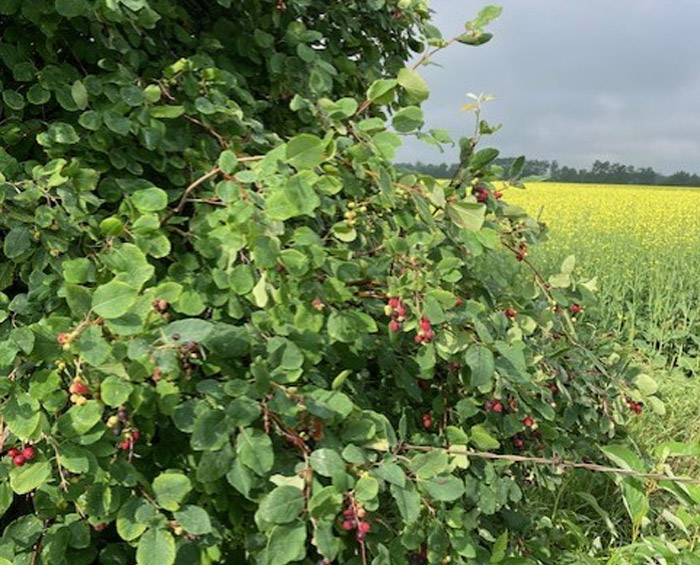I walk our dog every day down our gravel road. Once in a while, for a change of scenery, we go somewhere exotic to stroll: Bush Farm Road in Steinbach, or the unpretentious Tetrault Park walk in La Broquerie. But generally, day in, day out, winter or summer, rain, sun or snow, minus 40 or plus 36 with a humidex of 45, and all the days in between, you can find my dog Winnie and I sauntering alongside this grid road bordered with shelterbelts and fields and farmyards, greeting the day.
A shelterbelt, according to an Agriculture Canada definition, is “a row of trees or shrubs that grows along field boundaries, adjacent to roads and waterways, and around farmyards and livestock facilities… used to mitigate the effect of soil erosion due to wind; protect homes, crops, and livestock; control snow blowing over roads; and provide wildlife habitat”. Prairie farmers have been planting shelterbelts for well over a hundred years, and it is only with the amalgamation of small farms, development of low or no-till farming practices and the increased power and size of land-clearing and farming equipment that shelterbelts are now being considered out-dated and even a modern inconvenience.
The shelterbelt near our place is a constant source of change and delight. Many birds and small critters make their home there. Wildflowers as diverse in colour and size as the insects that frequent them grow at the feet of the various trees and shrubs that make up this mature ecosystem. If we are lucky enough, if the weather cooperates and the frosts don’t continue too far into spring, if the rains are timely and there are just the right amount of sunny days, we have the total delight of finding ripe, juicy Saskatoon berries in late June or early July. Several weeks later, there are often chokecherries to be found, and after that acorns, but the early Saskatoons, the first berries that I tend to pick in summer are a most memorable treat. They emanate abundance, and I rarely feel as fortunate or as content as when I am knee-deep in wild grasses, listening to birds call and dart around me, picking purple-pink bites of summery sweetness, with my dog panting happily at my feet.
Wendell Berry makes it a practice to notice and write poignantly about Nature and our relationship with her.
“We have the world to live in on the condition that we will take good care of it. And to take good care of it, we have to know it. And to know it and to be willing to take care of it, we have to love it.”
This quote reminds me of my relationship with our shelterbelt. And because I do know it and love it, I found myself, two winters previous, flagging down a huge brush-cutting machine, in a panic since it was rapidly eating through metres and years of growth; animal habitat and berry havens gobbled up in mere minutes, its operator completely oblivious to the devastation she was wreaking in our shelterbelt and in my heart. Several minutes of indecision and timidity cost me a quarter mile of shelterbelt by the time I became brave enough to approach this loud, oak-grinding, habitat-swallowing machine. But she stopped, and was kind enough to listen to our entreaties and call up her boss. It was MB Hydro of course, clearing underneath their hydrolines so that there wouldn’t be outages from storms and fallen trees come summertime. I pointed out that there was only one actual tree growing in this shelterbelt, a lone oak, that despite being likely 40 years old would take another 25-30 to reach tall enough to be a threat. The remainder of the foliage were caraganas and hawthorns, saskatoon and chokecherry bushes, none of which at full maturity would grow to the height of endangering nearby people or power sources. A reasonable discourse ensued, and while we lost the fight for the “menacing” oak, the remainder of the shelterbelt was left in its winter repose.
And this spring, with much gratitude, we are basking in the bounty of that bravery with the largest and most prolific saskatoon harvest we have ever seen in our 16 summers here.
“Knowing that you love the earth changes you, activates you to defend and protect and celebrate. But when you feel that the earth loves you in return, that feeling transforms the relationship from a one-way street into a sacred bond.” ~ Robin Wall Kimmerer, Braiding Sweetgrass: Indigenous Wisdom, Scientific Knowledge and the Teachings of Plants




